Dragging Core2Duo into 2013: Time for an Upgrade?
by Ian Cutress on January 15, 2013 12:30 PM EST- Posted in
- CPUs
As any ‘family source of computer information’ will testify, every so often a family member will want an upgrade. Over the final few months of 2012, I did this with my brother’s machine, fitting him out with a Sandy Bridge CPU, an SSD and a good GPU to tackle the newly released Borderlands 2 with, all for free. The only problem he really had up until that point was a dismal FPS in RuneScape.
The system he had been using for the two years previous was an old hand-me-down I had sold him – a Core2Duo E6400 with 2x2 GB of DDR2-800 and a pair of Radeon HD4670s in Crossfire. While he loves his new system with double the cores, a better GPU and an SSD, I wondered how much of an upgrade it had really been.
I have gone through many upgrade philosophies over the decade. My current one to friends and family that ask about upgrades is that if they are happy installing new components. then upgrade each component to one of the best in its class one at a time, rather than at an overall mediocre setup, as much as budget allows. This tends towards outfitting a system with a great SSD, then a GPU, PSU, and finally a motherboard/CPU/memory upgrade with one of those being great. Over time the other two of that trio also get upgraded, and the cycle repeats. Old parts are sold and some cost is recouped in the process, but at least some of the hardware is always on the cutting edge, rather than a middling computer shop off-the-shelf system that could be full of bloatware and dust.
As a result of upgrading my brother's computer, I ended up with his old CPU/motherboard/memory combo, full of dust, sitting on top of one of my many piles of boxes. I decided to pick it up and run the system with a top range GPU and an SSD through my normal benchmarking suite to see how it faired to the likes of the latest FM2 Trinity and Intel offerings, both at stock and with a reasonable overclock. Certain results piqued my interest, but as for normal web browsing and such it still feels as tight as a drum.
The test setup is as follows:
Core2Duo E6400 – 2 cores, 2.13 GHz stock
2x2 GB OCZ DDR2 PC8500 5-6-6
MSI i975X Platinum PowerUp Edition (supports up to PCIe 1.1)
Windows 7 64-bit
AMD Catalyst 12.3 + NVIDIA 296.10 WHQL (for consistency between older results)
My recent testing procedure in motherboard reviews pairs the motherboard with an SSD and a HD7970/GTX580, and given my upgrading philosophy above, I went with these for comparable results. The other systems in the results used DDR3 memory in the range of 1600 C9 for the i3-3225 to 2400 C9 for the i7-3770K.
The Core2Duo system was tested at stock (2.13 GHz and DDR2-533 5-5-5) and with a mild overclock (2.8 GHz and DDR2-700 5-5-6).
Gaming Benchmarks
Games were tested at 2560x1440 (another ‘throw money at a single upgrade at a time’ possibility) with all the eye candy turned up, and results were taken as the average of four runs.
Metro2033
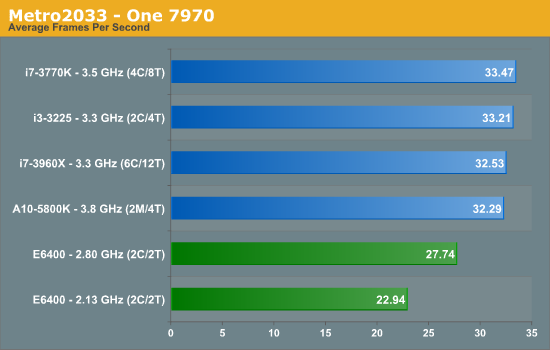
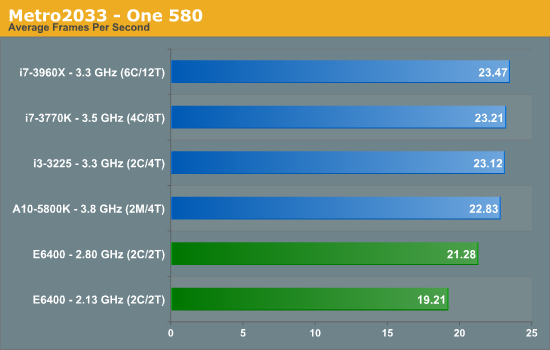
While an admirable effort by the E6400, and overclocking helps a little, the newer systems get that edge. Interestingly the difference is not that much, with an overclocked E6400 being within 1 FPS of an A10-5800K at this resolution and settings while using a 580.
Dirt3
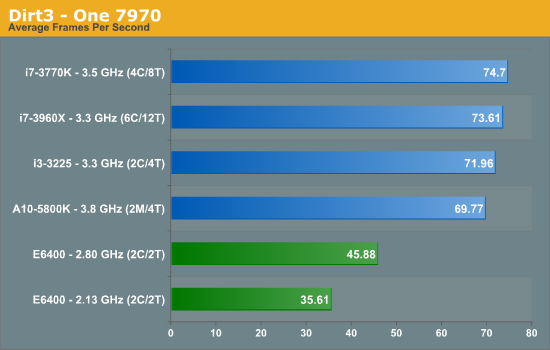

The bump by the overclock makes Dirt3 more playable, but it still lags behind the newer systems.
Computational Benchmarks
3D Movement Algorithm Test
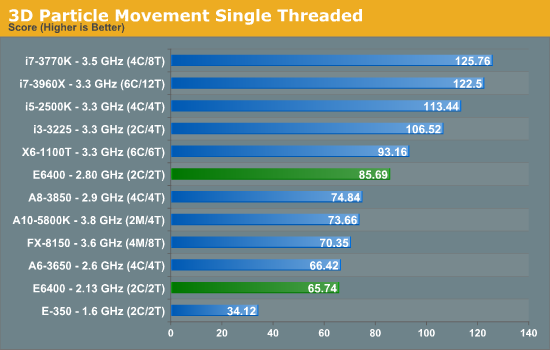
This is where it starts to get interesting. At stock the E6400 lags at the bottom but within reach of an FX-8150 4.2 GHz , but with an overclock the E6400 at 2.8 GHz easily beats the Trinity-based A10-5800K at 4.2 GHz. Part of this can be attributed to the way the Bulldozer/Piledriver CPUs deal with floating point calculations, but it is incredible that a July 2006 processor can beat an October 2012 model. One could argue that a mild bump on the A10-5800K would put it over the edge, but in our overclocking of that chip anything above 4.5 GHz was quite tough (we perhaps got a bad sample to OC).
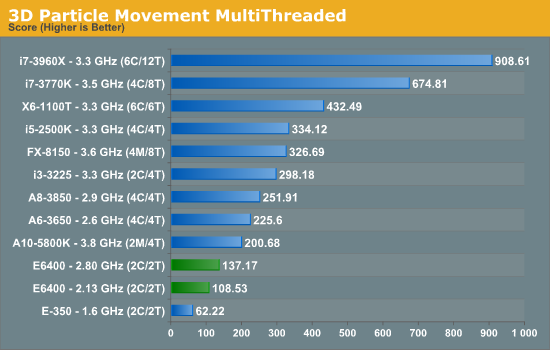
Of course the situation changes when we hit the multithreaded benchmark, with the two cores of the E6400 holding it back. However, if we were using a quad core Q6600, stock CPU performance would be on par with the A10-5800K in an FP workload, although the Q6600 would have four FP units to calculate with and the A10-5800K only has two (as well as the iGPU).
WinRAR x64 3.93 - link

In a variable threaded workload, the DDR2 equipped E6400 is easily outpaced by any modern processor using DDR3.
FastStone Image Viewer 4.2 - link
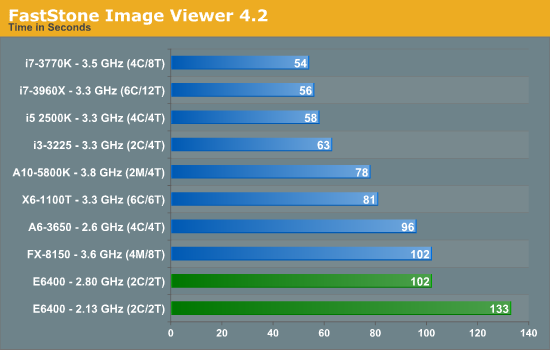
Despite FastStone being single threaded, the increased IPC of the later generations usually brings home the bacon - the only difference being the Bulldozer based FX-8150, which is on par with the E6400.
Xilisoft Video Converter
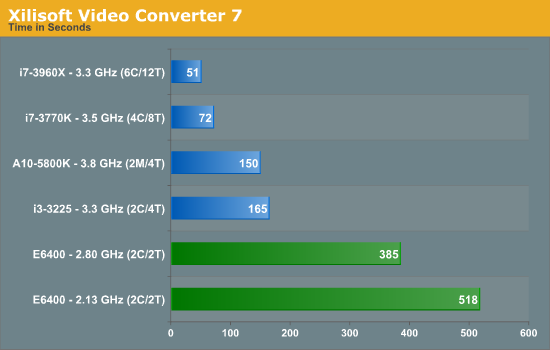
Similarly with XVC, more threads and INT workloads win the day.
x264 HD Benchmark
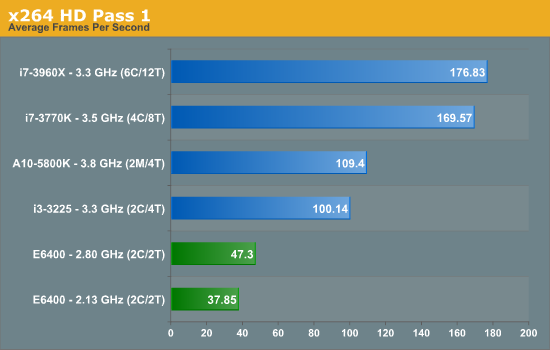
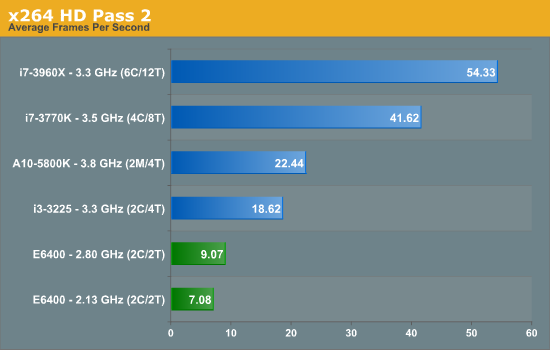
Conclusions
When I start a test session like this, my first test is usually 3DPM in single thread mode. When I got that startling result, I clearly had to dig deeper, but the conclusion produced by the rest of the results is clear. In terms of actual throughput benchmarks, the E6400 is comparatively slow to all the modern home computer processors, either limited by cores or by memory.
This was going to be obvious from the start.
In the sole benchmark which does not rely on memory or thread scheduling and is purely floating point based the E6400 gives a surprise result, but nothing more. In our limited gaming tests the E6400 copes well at 2560x1440, with that slight overclock making Dirt3 more playable.
But the end result is that if everything else is upgraded, and the performance boost is cost effective, even a move to an i3-3225 or A10-5800K will yield real world tangible benefits, alongside all the modern advances in motherboard features (USB 3.0, SATA 6 Gbps, mSATA, Thunderbolt, UEFI, PCIe 2.0/3.0, Audio, Network). There are also significant power savings to be had with modern architectures.
My brother enjoys playing his games at a more reasonable frame rate now, and he says normal usage has sped up by a bit, making watching video streams a little smoother if anything. The only question is where Haswell will come in to this, and is a question I look forward to answering.


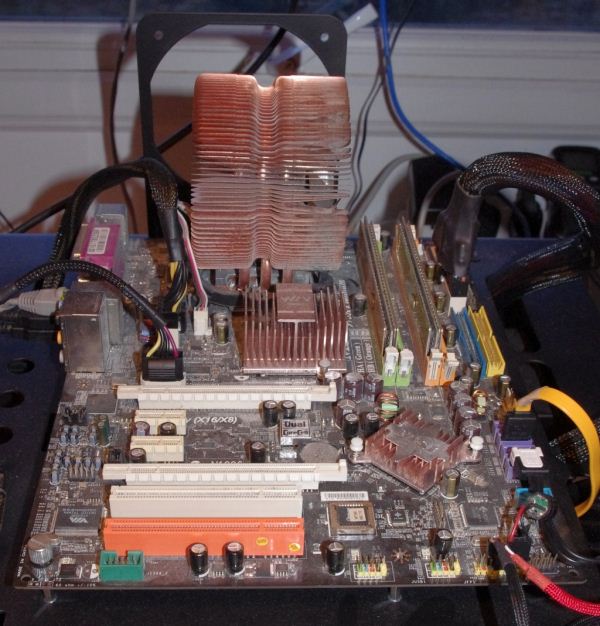








136 Comments
View All Comments
IanCutress - Tuesday, January 15, 2013 - link
Benchmark is written in plain C++, without extensions, similar to any non-CompSci oriented scientist who has been told to 'write code' to solve a problem.Using the SSE4 C++ AMP n-body example in the SDK, at 10240 bodies in the calculation, the E6400 gets 3.8 GFlops at 2.13 GHz compared to 42.3 GFlops for an i7-3770K, if that helps :)
tocket - Tuesday, January 15, 2013 - link
In that case: Good on Intel! That's a more than 3-fold improvement on a core-frequency basis if we're talking multithreaded here. Too bad this improvement does not come automatically though. There's probably a whole lot of programs that don't make use of these extensions.BTW, nice to see a chemist on Anandtech. Keeps my fantasy of seeing a Gaussian09 bench on a Xeon Phi alive :)
IanCutress - Tuesday, January 15, 2013 - link
Oh I should say that n-body was MultiThreaded. Don't have ST numbers, sorry :(I don't have access to Gaussian09, but if there's a Linux+OpenMP version, link me up and I'll see what I can do if I get a Xeon Phi in :)
Golgatha - Wednesday, January 16, 2013 - link
Bunch of in-silico nutters. Get into the lab and get your hands dirty!IanCutress - Saturday, January 19, 2013 - link
Things always go boom when I'm in the lab. At least it takes me a couple of years to burn out a $300 GPU rather than a couple of minutes to have $10k of chemicals explode in my face / get washed down the drain :)danjw - Tuesday, January 15, 2013 - link
I just did an upgrade from Core2Quad Q9450 to a Core i7-3570K and some new Corsair DDR3-1600 memory. I went with the Asus P8Z77-V LK motherboard. I already had a Corsair 60GB SSD I had been using as a boot drive. For the new system, I moved the SSD to being used for Smart Response on an 1GB EARZX Western Digial drive. Those two went on the SATA 6Gbps ports and some other data drives and optical on the SATA 3Gbps ports. I kept my EVGA GeForce GTX 560 Ti graphics card. I decided to stick with Windows 7 Home Premium 64bit, for the upgrade.I haven't bench marked games, but in generally I am really happy with the new system. Everything in the OS happens significantly faster, though boot time is a little slower. The old system was having stability issues, so this was as much a repair as it was an upgrade. Also, some things like opening up my Chrome session and closing are much faster. Games do seem to be more responsive as well.
chrnochime - Tuesday, January 15, 2013 - link
For something like a computer, I would've just gave the pc to him instead of making money off my own family...chrnochime - Tuesday, January 15, 2013 - link
Then again you gave him the new system for free. Hmm..IanCutress - Tuesday, January 15, 2013 - link
Different times. Back then I was at university, where money was a scare resource, and after paying for my own new build I wanted to recoup some of the cost. Now in the world of jobs and such, it's less of an issue, and since he drives and I do not, his runabouts at my request have grown over time and I wanted to repay him.Ian
themossie - Wednesday, January 16, 2013 - link
Depends on the money situation, and surely it depends on the family?I don't give equipment to my family - if it's free, they treat it like crap and it breaks in weeks. And they have far more money than me...
For family, my time is free - and time is love. Gear is another story :-)